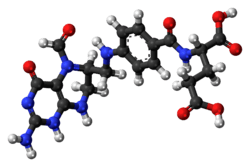Folinic acid
 | |
 | |
| Clinical data | |
|---|---|
| Pronunciation | Leucovorin /luːkoʊˈvɔːrɪn/ |
| Trade names | Many |
| AHFS/Drugs.com | Monograph |
| Pregnancy category | |
| Routes of administration | Intravenous, oral |
| ATC code | V03AF03 (WHO) |
| Legal status | |
| Legal status |
|
| Pharmacokinetic data | |
| Bioavailability | Dose dependent |
| Protein binding | ~15% |
| Biological half-life | 6.2 hours |
| Excretion | Urinary |
| Identifiers | |
| |
| CAS Number |
1492-18-8 |
| PubChem (CID) | 6006 |
| IUPHAR/BPS | 4816 |
| DrugBank |
DB00650 |
| ChemSpider |
5784 |
| UNII |
RPR1R4C0P4 |
| ChEMBL |
CHEMBL1679 |
| ECHA InfoCard | 100.014.621 |
| Chemical and physical data | |
| Formula | C20H23N7O7 |
| Molar mass | 473.44 g/mol |
| 3D model (Jmol) | Interactive image |
| Melting point | 245 °C (473 °F) decomp |
| |
| |
| | |

Folinic acid (BAN) or leucovorin (USAN), generally administered as the calcium or sodium salt (calcium folinate (INN), sodium folinate, leucovorin calcium, leucovorin sodium), is an adjuvant used in cancer chemotherapy involving the drug methotrexate.[1] It is also used in synergistic combination with the chemotherapy agent 5-fluorouracil.
Folinic acid (also called 5-formyltetrahydrofolate) was first discovered in 1948 as citrovorum factor and occasionally is still called by that name.[2] Folinic acid should be distinguished from folic acid (vitamin B9). However, folinic acid is a vitamer for folic acid, and has the full vitamin activity of this vitamin. It is on the World Health Organization's List of Essential Medicines, a list of the most important medication needed in a basic health system.[3]
Levofolinic acid and its salts are the 2S- form of the molecule. They are the only forms of the molecule that are known to be biologically active.
Medical use
Folinic acid is administered at the appropriate time following methotrexate as part of a total chemotherapeutic plan, where it may "rescue" bone marrow and gastrointestinal mucosa cells from methotrexate. No apparent effect is seen on pre-existing methotrexate-induced nephrotoxicity.[4] Folinic acid can be taken as a pill (orally) or injected into a vein (intravenously) or muscle (intramuscularly).[5]
While not specifically an antidote for methotrexate, folinic acid may also be useful in the treatment of acute methotrexate overdose. Different dosing protocols are used, but folinic acid should be redosed until the methotrexate level is less than 5 x 10−8 M.[6]
Additionally, folinic acid is sometimes used to reduce the side effects of methotrexate in rheumatoid arthritis patients. This includes reductions in nausea, abdominal pain, abnormal liver blood tests, and mouth sores.[7]
Folinic acid is also used in combination with the chemotherapy agent 5-fluorouracil in treating colon cancer. In this case, folinic acid is not used for "rescue" purposes; rather, it enhances the effect of 5-fluorouracil by inhibiting thymidylate synthase.
Folinic acid is also sometimes used to prevent toxic effects of high doses of antimicrobial dihydrofolate reductase inhibitors such as trimethoprim and pyrimethamine. It may be prescribed in the treatment of toxoplasmosis retinitis, in combination with the folic acid antagonists pyrimethamine and sulfadiazine.
Folinic acid has dextro- and levorotary isomers, only the latter one being pharmacologically useful. As such, levoleucovorin was approved by the FDA in 2008.[8]
It has been investigated for use in Down syndrome, but a benefit has not been demonstrated.[9]
Recently, an open label trial of high dose folinic acid showed improvements in children with autism spectrum disorder (ASD) These findings have been replicated in a double blind placebo controlled trial of oral high dose folinic acid in children with autism and verbal communication impairments.[10]
Research has suggested a role for folinic acid in the treatment of anxiety and depression in people with a variant of the MTHFR gene.[11]
Side effects
Folinic acid should not be administered intrathecally. This may produce severe adverse effects or even death.[12]
Drug interactions
Fluorouracil: Folinic acid may increase the toxicity associated with fluorouracil if the two are administered together. Some adverse effects that have occurred, particularly in elderly patients, include severe enterocolitis, diarrhea, and dehydration.[13]
Sulfamethoxazole-trimethoprim: A potential drug interaction exists with concomitant use of sulfamethoxazole-trimethoprim and folinic acid. Folinic acid has been shown to decrease the efficacy of sulfamethoxazole-trimethoprim in the treatment of pneumocystis carinii, a common cause of pneumonia in AIDS patients.[14]
Mechanism of action
Folinic acid is a 5-formyl derivative of tetrahydrofolic acid. It is readily converted to other reduced folic acid derivatives (e.g., tetrahydrofolate), thus has vitamin activity equivalent to that of folic acid. Since it does not require the action of dihydrofolate reductase for its conversion, its function as a vitamin is unaffected by inhibition of this enzyme by drugs such as methotrexate. This is the classical view of folinic acid rescue therapy. In 1980s, however, folinic acid was found to reactivate the dihydrofolate reductase itself even when methotrexate exists. Although the mechanism is not very clear, the polyglutamylation of methotrexate and dihydrofolate in malignant cells is considered to play an important role in the selective reactivation of dihydrofolate reductase by folinic acid in normal cells.[15]
Folinic acid, therefore, allows for some purine/pyrimidine synthesis to occur in the presence of dihydrofolate reductase inhibition, so some normal DNA replication processes can proceed.
History
Folinic acid was discovered as a needed growth factor for the bacterium Leuconostoc citrovorum in 1948, by Sauberlich and Baumann. This resulted in it being called "citrovorum factor," meaning citrovorum growth factor. It had an unknown structure, but was found to be a derivative of folate that had to be metabolized in the liver before it could support growth of L. citrovorum. The synthesis of citrovorum factor by liver cells in culture was eventually accomplished from pteroylglutamic acid in the presence of suitable concentrations of ascorbic acid. The simultaneous addition of sodium formate to such systems resulted in increased citrovorum factor activity in the cell-free supernatants (producing, as now known, the 5-formyl derivative), and from this method of preparation of large amounts of the factor, its structure as levo-folinic acid (5-formyl tetrahydrofolic acid) was eventually deduced.
References
- ↑ Keshava, Channa; Keshava, Nagalakshmi; Whong, Wen-Zong; Nath, Joginder; Ong, Tong-man (1998). "Inhibition of methotrexate-induced chromosomal damage by folinic acid in V79 cells". Mutation Research/Fundamental and Molecular Mechanisms of Mutagenesis. 397 (2): 221–8. doi:10.1016/S0027-5107(97)00216-9. PMID 9541646.
- ↑ Doctor, V. M.; Couch, J. R. (1953). "Occurrence and properties of a conjugated form of Leuconostoc citrovorum factor". The Journal of Biological Chemistry. 200 (1): 223–31. PMID 13034776.
- ↑ "WHO Model List of EssentialMedicines" (PDF). World Health Organization. October 2013. Retrieved 22 April 2014.
- ↑ Therapeutic Information Resources Australia (2004). Calcium Folinate (Systemic) in AUSDI: Australian Drug Information for the Health Care Professional. Castle Hill: Therapeutic Information Resources Australia.
- ↑ McGuire, B. W.; Sia, L. L.; Leese, P. T.; Gutierrez, M. L.; Stokstad, E. L. (1988). "Pharmacokinetics of leucovorin calcium after intravenous, intramuscular, and oral administration". Clinical pharmacy. 7 (1): 52–8. PMID 3257913.
- ↑ http://www.cancercare.on.ca/pdfdrugs/leucovo.pdf[]
- ↑ Shea, Beverley; Swinden, Michael V; Tanjong Ghogomu, Elizabeth; Ortiz, Zulma; Katchamart, Wanruchada; Rader, Tamara; Bombardier, Claire; Wells, George A; Tugwell, Peter (2013). "Folic acid and folinic acid for reducing side effects in patients receiving methotrexate for rheumatoid arthritis". Cochrane Database of Systematic Reviews. 5: CD000951. doi:10.1002/14651858.CD000951.pub2. PMID 23728635.
- ↑ Drugs.com (2008-05-07). "FDA Approves Levoleucovorin". Retrieved 2009-06-07.
- ↑ Ellis, J. M.; Tan, H. K.; Gilbert, R. E.; Muller, D. P.; Henley, W; Moy, R; Pumphrey, R; Ani, C; Davies, S; Edwards, V; Green, H; Salt, A; Logan, S (March 2008). "Supplementation with antioxidants and folinic acid for children with Down's syndrome: Randomised controlled trial". BMJ. 336 (7644): 594–7. doi:10.1136/bmj.39465.544028.AE. PMC 2267988
 . PMID 18296460.
. PMID 18296460. - ↑ Frye, R. E.; Slattery, J.; Delhey, L.; Furgerson, B.; Strickland, T.; Tippett, M.; Sailey, A.; Wynne, R.; Rose, S. (2016-10-18). "Folinic acid improves verbal communication in children with autism and language impairment: a randomized double-blind placebo-controlled trial". Molecular Psychiatry. doi:10.1038/mp.2016.168. ISSN 1476-5578.
- ↑ http://www.adelaidenow.com.au/lifestyle/sa-lifestyle/how-a-vitamin-cured-my-anxiety-elisa-blacks-story-of-lifelong-struggle-and-new-hope-for-the-future/story-fnizi7vf-1227251037624
- ↑ Jardine, Lawrence F.; Ingram, Lewis C.; Bleyer, W. Archie (1996). "Intrathecal Leucovorin After Intrathecal Methotrexate Overdose". Journal of Pediatric Hematology/Oncology. 18 (3): 302–4. doi:10.1097/00043426-199608000-00014. PMID 8689347.
- ↑ Trissel, L. A.; Martinez, J. F.; Xu, Q. A. (1995). "Incompatibility of fluorouracil with leucovorin calcium or levoleucovorin calcium". American Journal of Health-System Pharmacy. 52 (7): 710–5. PMID 7627739.
- ↑ Razavi, B; Lund, B; Allen, B. L.; Schlesinger, L (2002). "Failure of trimethoprim/sulfamethoxazole prophylaxis for Pneumocystis carinii pneumonia with concurrent leucovorin use". Infection. 30 (1): 41–2. doi:10.1007/s15010-001-1172-0. PMID 11876516.
- ↑ Goldman, I. D.; Matherly, L. H. (1987). "Biochemical factors in the selectivity of leucovorin rescue: Selective inhibition of leucovorin reactivation of dihydrofolate reductase and leucovorin utilization in purine and pyrimidine biosynthesis by methotrexate and dihydrofolate polyglutamates". NCI monographs (5): 17–26. PMID 2448654.